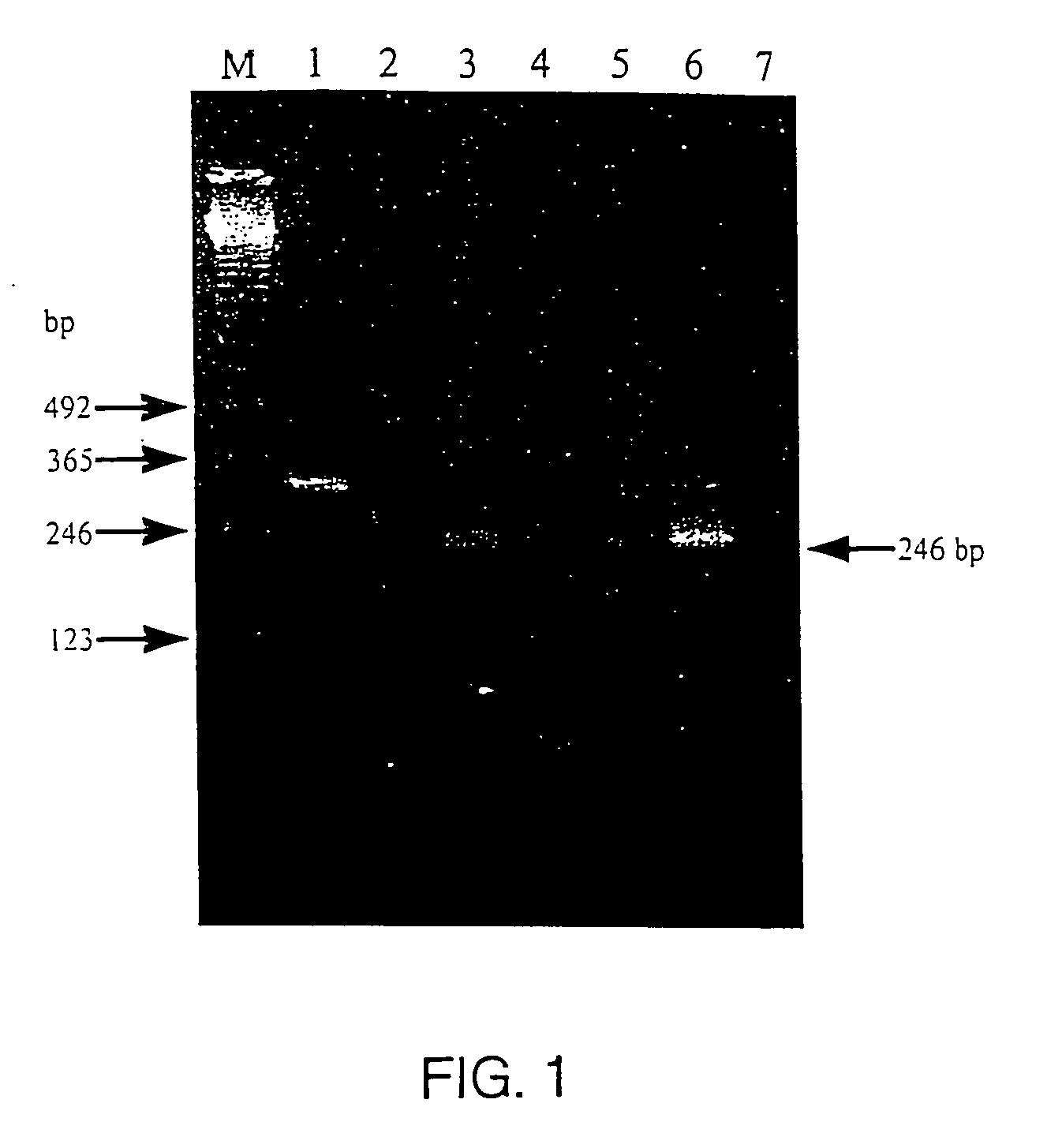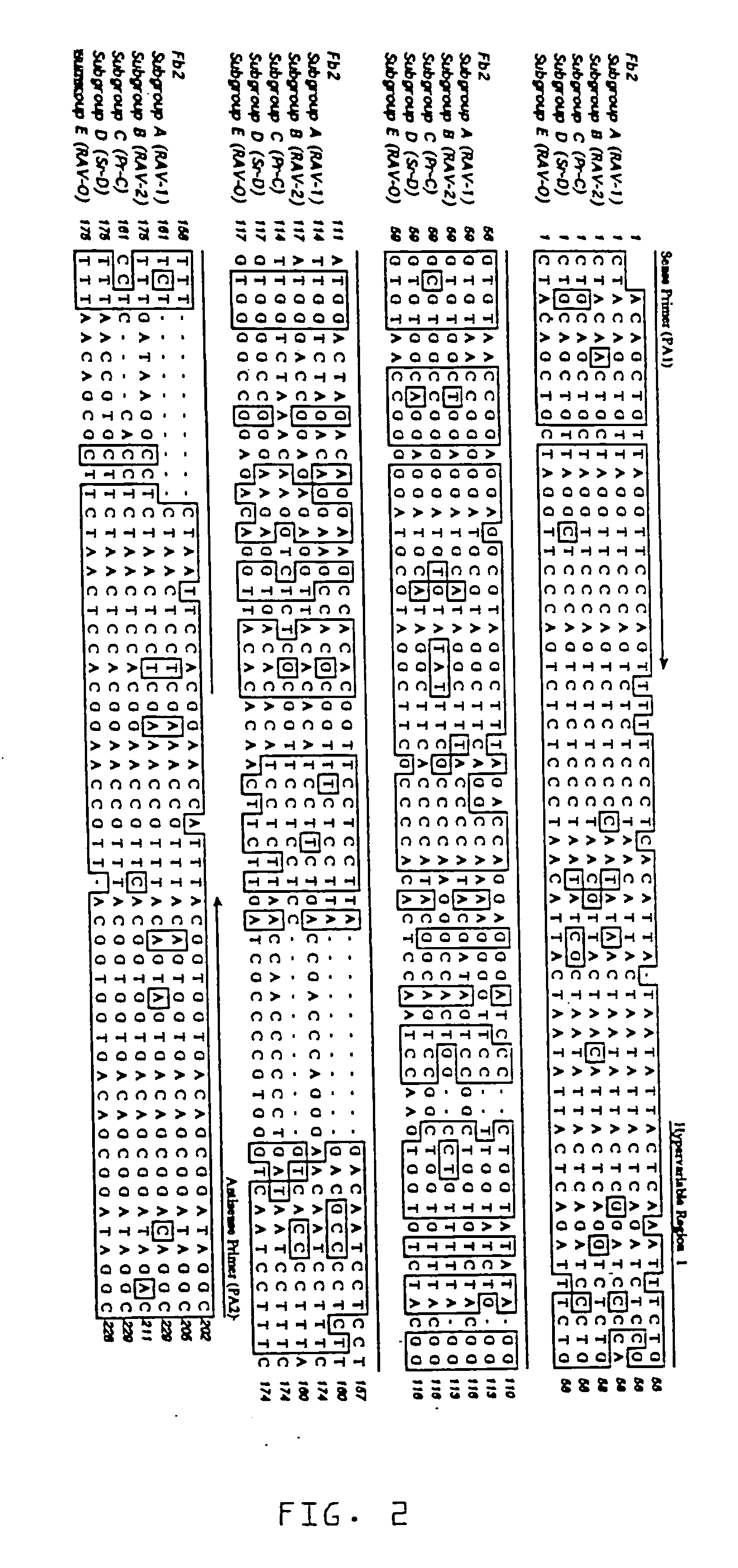Viral detection system
a detection system and virus technology, applied in the field of poultry virology and oncogenesis and cancer epidemiology in humans, can solve the problems of reducing egg production, reducing growth rate, adverse effects of commercial chickens on poultry and egg production, etc., and achieves rapid detection of alsv retroviruses and effective detection of avian leukosis/sarcoma
- Summary
- Abstract
- Description
- Claims
- Application Information
AI Technical Summary
Benefits of technology
Problems solved by technology
Method used
Image
Examples
example 1
[0036] Poultry Specimens Tested for Virus and Viral Antigen.
[0037] Three stocks of Single Comb White Leghorn chickens, referred to as Q, F and N, were used. Albumen samples from unfertilized eggs were used, as well as samples of feather pulp and blood from adult birds. Egg albumen from unfertilized eggs was used to: 1) limit false positive reactions due to avian leukosis endogenous proviruses potentially established in parental genes found in fertilized eggs, or in maternal genes found in the vitelline membrane surrounding the egg yolk; and 2) to limit false negative reactions due to inactivation of ALSV by maternal antibodies, such as IgY, found in the egg yolk (Yamamoto, T., et al., Hen Eggs. Their Basic and Applied Science, CRC Press, Boca Raton (1997); Kottaridis, S. D., et al., Avian Diseases, 11:65-68 (1967); Smith E. J. In: De Boer, G. F., ed. Avian Leukosis. Developments in Veterinary Virology, Martinus Nijhoff Publishing, Boston, Mass. (1987)).
[0038] Stock Q chickens (n=5...
example 2
[0042] Tissue Culture Testing of Albumen, Feather Pulp, and Blood Samples
[0043] Egg albumen, feather pulp, and blood samples were tested for viral presence, via immunofluorescence (IFA) by inoculating samples onto cultures of chicken embryo fibroblasts (C / E), which were susceptible to subgroups A-D of avian leukosis / sarcoma virus but not subgroup E. Immunofluorescence analysis was performed on C / E cells inoculated with chicken egg albumen, feather pulp and blood specimens to detect the gsa of replicating ALSV. The C / E cells were recovered from storage at −196° C. An aliquot of C / E cells was tested for viabiiity by trypan blue staining and then 45,000 viable cells in 150 ml of medium were added to each well in a 96 well plate.
[0044] Four to 18 hours after plating of cells, the cultures were inoculated with 50 ml of egg albumen, feather pulp, or blood samples. Serial dilutions of RAV-1 and RAV-2 served as positive controls and uninoculated cultures were negative controls. After 6 da...
example 3
[0045] IFA and ELISA Analysis of Egg Albumen, Feather Pulp, or Blood Samples
[0046] Both immunofluorescence and ELISA were used to screen for viruses in chickens. Viral infection was detected by testing for avian leukosis / sarcoma virus group specific antigen (gsa) by ELISA or IFA (Spencer, J. L., In. G. F. De Boer (Ed.), Avian Leukosis. Developments in Veterinary Virology, Martinus Nijhoff Publishing, pp. 213-240. 1987). ELISA was performed on the egg albumen to detect avian leukosis / sarcoma virus gs antigens, while IFA analysis was performed on C / E cells inoculated with chicken egg albumen, feather pulp and blood specimens to detect the gs antigens of replicating ALSV.
[0047] In addition to the immunofluorescence analysis, ELISA was also performed on the egg albumen samples from the stock Q and F birds. The procedure for the antigen capture ELISA has been described (Spencer, J. L., In: G. F. De Boer (Ed.), Avian Leukosis. Developments in Veterinary Virology. Martinus Nijhoff Publis...
PUM
| Property | Measurement | Unit |
|---|---|---|
| Fraction | aaaaa | aaaaa |
| Temperature | aaaaa | aaaaa |
| Temperature | aaaaa | aaaaa |
Abstract
Description
Claims
Application Information
 Login to View More
Login to View More - R&D
- Intellectual Property
- Life Sciences
- Materials
- Tech Scout
- Unparalleled Data Quality
- Higher Quality Content
- 60% Fewer Hallucinations
Browse by: Latest US Patents, China's latest patents, Technical Efficacy Thesaurus, Application Domain, Technology Topic, Popular Technical Reports.
© 2025 PatSnap. All rights reserved.Legal|Privacy policy|Modern Slavery Act Transparency Statement|Sitemap|About US| Contact US: help@patsnap.com



